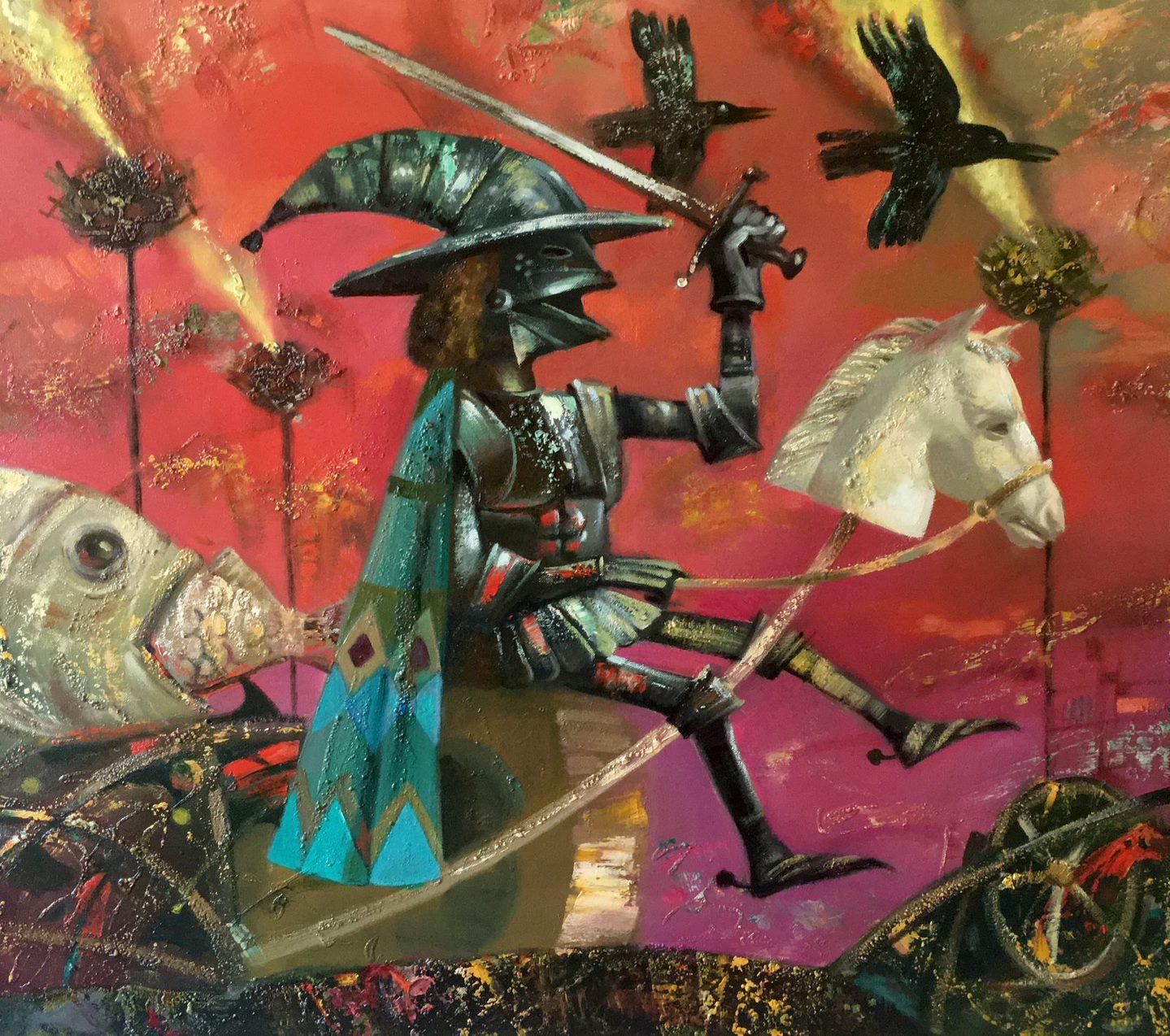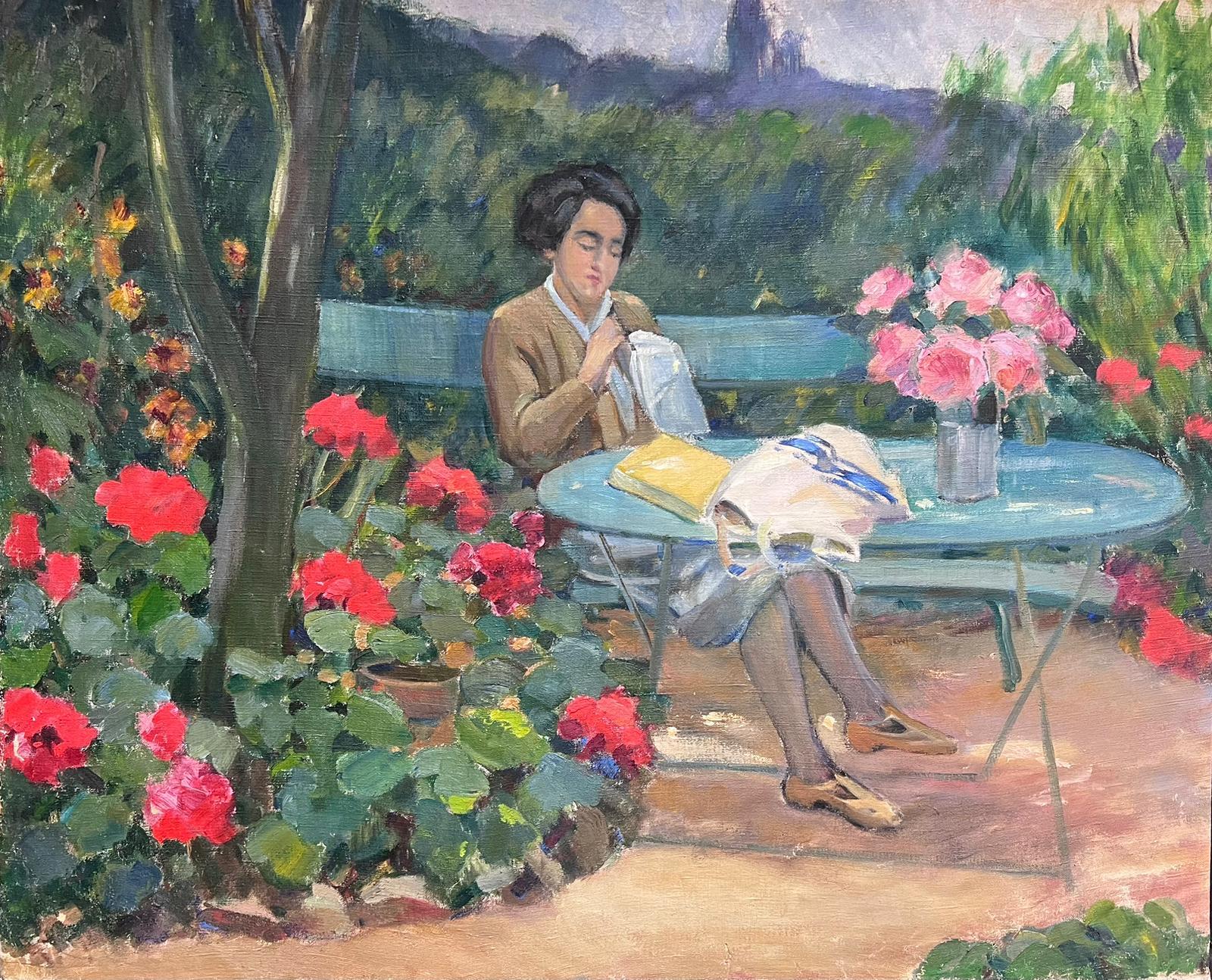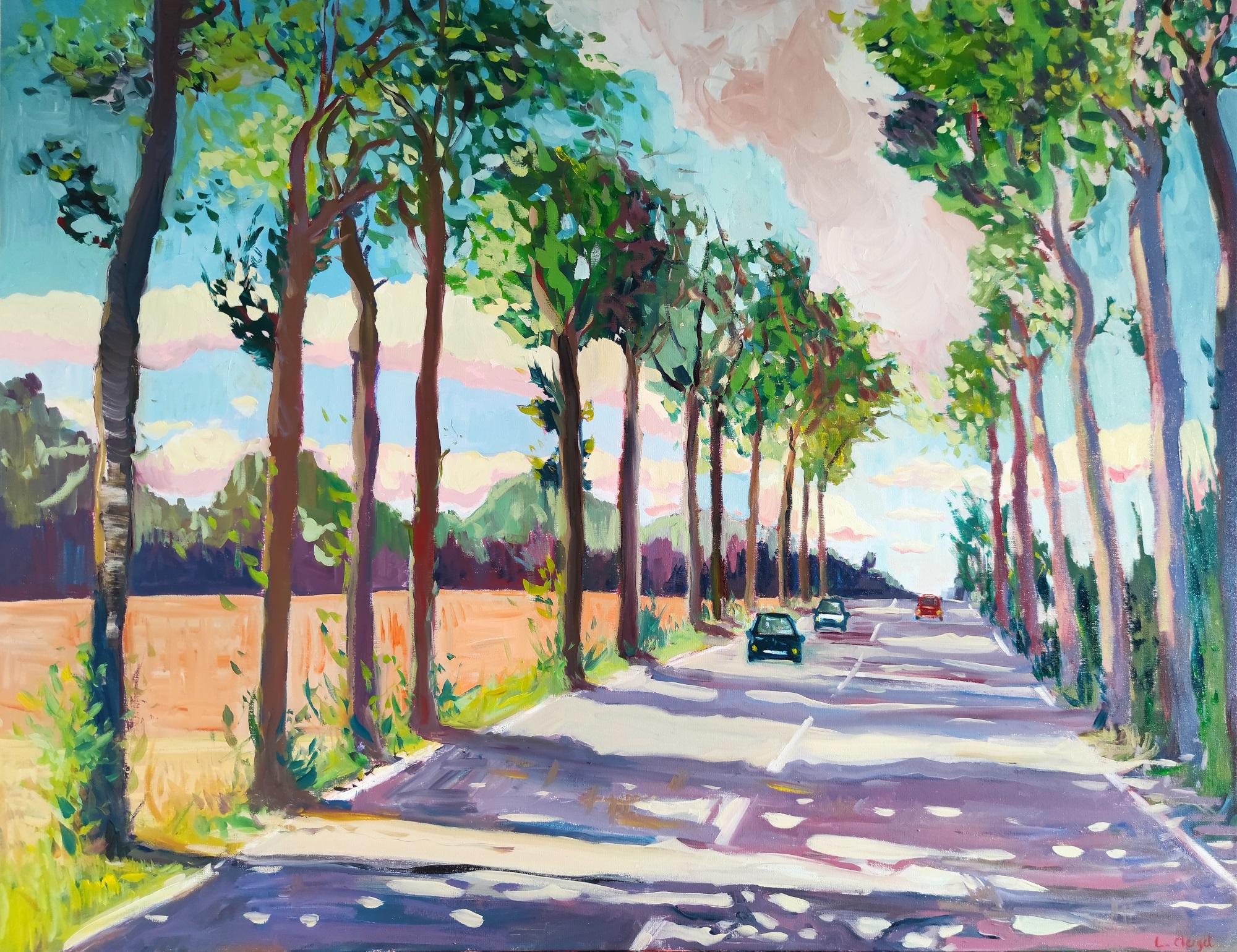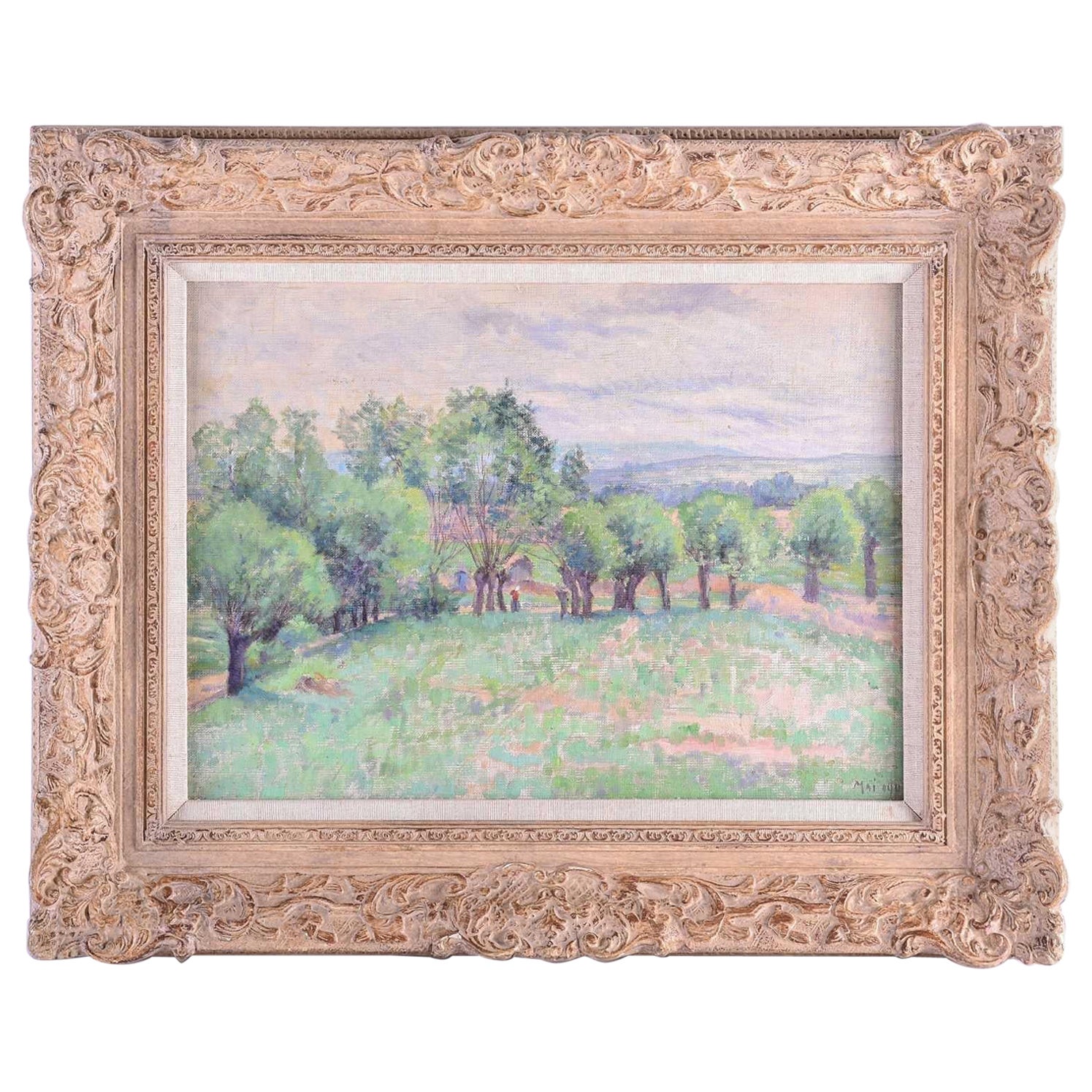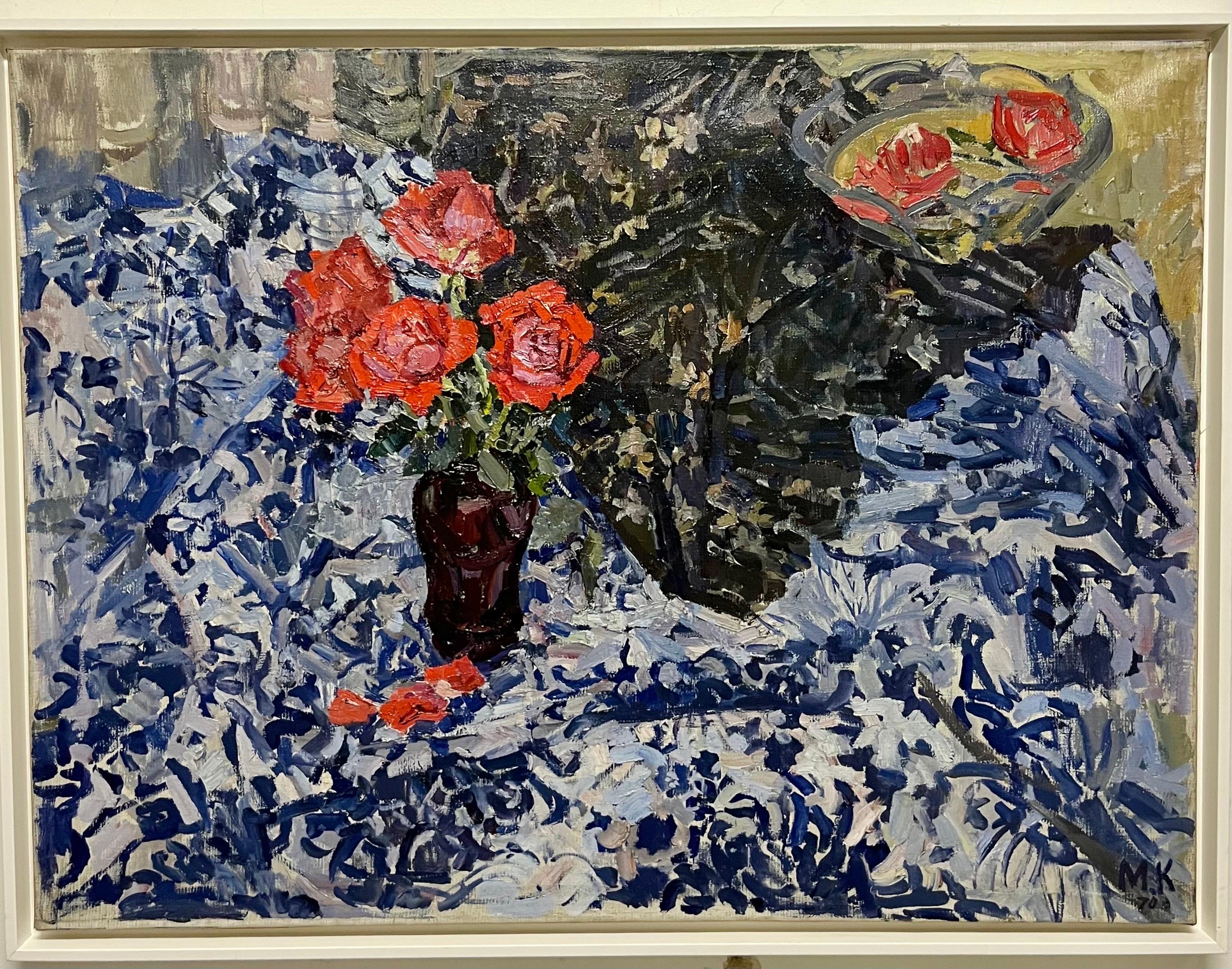Pierre-Auguste RenoirVue prise des Collettes, Cagnes by Pierre-Auguste Renoir - Landscape paintingcirca 1910-11
circa 1910-11
About the Item
- Creator:Pierre-Auguste Renoir (1841-1919, French)
- Creation Year:circa 1910-11
- Dimensions:Height: 11.03 in (28 cm)Width: 18 in (45.7 cm)
- Medium:
- Movement & Style:
- Period:
- Condition:
- Gallery Location:London, GB
- Reference Number:1stDibs: LU261212236772
Pierre-Auguste Renoir
An early 20th-century master, Pierre-Auguste Renoir created thousands of figurative prints and paintings and is credited as one of the founders of the Impressionist movement. His frequently reproduced works are appreciated for their luminous appearance, rich colors and soft, feathered brushstrokes.
Renoir was born in Limoges, France, in 1841. He began painting as a child while working in a porcelain factory, which led to a formal study of art in Paris under Charles Gleyre. In the early 1860s, he often visited the Louvre to study French master painters, and he became friends with Claude Monet and Alfred Sisley, both leading Impressionists.
Renoir first exhibited his paintings in 1864, but he did not rise to prominence until his first exhibition with the Impressionists in 1874. In 1877, Renoir stopped exhibiting with the Impressionists and embarked on a series of travels. In 1881, he went to Algeria and Spain, meeting the artists Eugène Delacroix and Diego Velázquez. He continued to Rome, Sicily, Algeria and Guernsey, where he created 15 paintings in one month in the summer of 1883.
In 1890, Renoir married Aline Victorine Charigot, a portrait model and muse for many of his works. They had three sons, and in 1907, Renoir moved his family to the village of Cagnes-sur-Mer, near the Mediterranean. By this time, he had developed arthritis in his hands, and he had a stroke in 1912, after which he used a wheelchair. Renoir continued to paint for the rest of his life, even strapping a brush to his paralyzed fingers.
Shortly before his death in 1919, Renoir visited the Louvre to see his paintings now hanging next to the artistic icons that he used to study and admire. He returned to his home village and died in December of that year.
On 1stDibs, find Pierre-Auguste Renoir paintings, prints and sculptures.
- ShippingRetrieving quote...Ships From: London, United Kingdom
- Return PolicyA return for this item may be initiated within 7 days of delivery.
- The Island, DANIEL RIDGWAY KNIGHT - American Impressionist, Realism, Landscape,By Daniel Ridgway KnightLocated in London, GBOil on canvas 46 x 55 cm (18 ⅛ x 21 ⅝ inches) Signed lower left, Ridgway Knight Artist biography American artist Daniel Ridgway Knight was born in Pennsylvania and studied at the École des Beaux-Arts in Paris. From 1872 he lived and worked at Poissy on the River Seine, just to the west of Paris. Best known for his landscapes and depictions of peasant women in the fields, Knight earned distinction at the Paris Salon of 1882. He went to be was awarded the Silver Medal and Cross of the Legion d’Honneur at the Exposition Universelle in 1889, the Gold Medal of Honour from the Pennsylvania Academy of Fine Arts in 1893 and in that same year was created a Knight of the Royal Order...Category
Late 19th Century American Impressionist Landscape Paintings
MaterialsOil, Canvas
- Vue de la Côte Normande by Claude-Émile Schuffenecker - Landscape paintingBy Claude Emile SchuffeneckerLocated in London, GB*PLEASE NOTE UK BUYERS WILL ONLY PAY 5% VAT ON THIS PURCHASE. Vue de la Côte Normande by Claude-Émile Schuffenecker (1851-1934) Oil on canvas 58 x 69 cm (22 ⁷/₈ x 27 ¹/₈ inches) Sig...Category
1890s Impressionist Figurative Paintings
MaterialsCanvas, Oil
- La Rivière Orne et le Pain de S by PAULÉMILE PISSARRO - Oil, Post-ImpressionistBy Paul Emile PissarroLocated in London, GB*UK BUYERS WILL PAY AN ADDITIONAL 20% VAT ON TOP OF THE ABOVE PRICE La Rivière Orne et le Pain de Sucre by PAULÉMILE PISSARRO (1884-1972) Oil on canvas 54 x 65 cm (21 ¼ x 25 ⅝ inch...Category
1940s Post-Impressionist Landscape Paintings
MaterialsCanvas, Oil
- Petit Saint-Véran et Boîte de Sel by Hugues Pissarro dit Pomié - Still LifeBy Hughes Claude PissarroLocated in London, GB*UK BUYERS WILL PAY AN ADDITIONAL 20% VAT ON TOP OF THE ABOVE PRICE Petit Saint-Véran et Boîte de Sel by Hugues Pissarro dit Pomié (b. 1935) Oil on canvas 92 x 73 cm (36 ¼ x 28 ¾ in...Category
Early 2000s Contemporary Still-life Paintings
MaterialsCanvas, Oil
- Tiger Surprises Black Buck by Orovida Pissarro - Animal paintingBy Orovida PissarroLocated in London, GB*UK BUYERS WILL PAY AN ADDITIONAL 20% VAT ON TOP OF THE ABOVE PRICE Tiger Surprises Black Buck by Orovida Pissarro (1893-1968) Oil on canvas 127 x 101.5 cm (50 x 40 inches) Signed and dated lower left Orovida 1960 Provenance The Leicester Galleries, London, circa 1965 Literature K L Erickson, Orovida Pissarro: Painter and Print-Maker with A Catalogue Raisonné of Paintings, (doctoral thesis), Oxford, 1992, Appendices, no. 195 (illustrated) Exhibition London, Royal Society of British Artists, 3rd-25th November 1960, no. 82 (possibly; titled Tiger Entangled) London, Royal Academy, 1961, no. 534 Colchester, The Minories, 3rd- 24th March 1962 London, The Leicester Galleries, 1965, no. 37 Artist biography Orovida Camille Pissarro, Lucien and Esther Pissarro’s only child, was the first woman in the Pissarro family as well as the first of her generation to become an artist. Born in Epping, England in 1893, she lived and worked predominantly in London where she became a prominent member of several British arts clubs and societies. She first learned to paint in the Impressionist style of her father, but after a brief period of formal study with Walter Sickert in 1913 she renounced formal art schooling. Throughout her career, Orovida always remained outside of any mainstream British art movements. Much to Lucien's disappointment she soon turned away from naturalistic painting and developed her own unusual style combining elements of Japanese, Chinese, Persian and Indian art. Her rejection of Impressionism, which for the Pissarro family had become a way of life, together with the simultaneous decision to drop her famous last name and simply use Orovida as a ‘nom de peintre’, reflected a deep desire for independence and distance from the weight of the family legacy. Orovida's most distinctive and notable works were produced from the period of 1919 to 1939 using her own homemade egg tempera applied in thin, delicate washes to silk, linen or paper and sometimes embellished with brocade borders. These elegant and richly decorative works generally depict Eastern, Asian and African subjects, such as Mongolian horse...Category
1960s Modern Animal Paintings
MaterialsCanvas, Oil
- Animal painting by Orovida Camille Pissarro titled 'Exercising Ponies'By Orovida PissarroLocated in London, GB*UK BUYERS WILL PAY AN ADDITIONAL 20% VAT ON TOP OF THE ABOVE PRICE Exercising Ponies by Orovida Camille Pissarro (1893-1968) Oil on board 101.5 x 76 cm (40 x 30 inches) Signed and dated lower right Orovida 1954 Provenance Estate of Orovida Pissarro With John Bensusan-Butt, cousin of the artist Sotheby's London, 12th October 1988 G Hassell, 25th November 1988 With John Noott, 10th June 1992 Literature K L Erickson, Orovida Pissarro: Painter and Print-Maker with A Catalogue Raisonné of Paintings, (doctoral thesis), Oxford, 1992, Appendices, no. 161 (illustrated) Exhibitions London, Bowmore Gallery, Women in Art 1850-1989, 2nd-11th November 1989 Fort Lauderdale, Museum of Art, Camille Pissarro and his Descendants, January-April 2000, no.123 This work was included in the above important museum exhibition and a catalogue of the Fort Lauderdale museum show will be included with this painting. Biography Orovida Camille Pissarro, the only child of Lucien and Esther Pissarro, was the first woman in the Pissarro family to become a professional artist and the first Pissarro of her generation to take up painting. Born in Epping, England, in 1893, she lived and worked predominantly in London, where she was a prominent member of several British arts clubs and societies. She first learned to paint in the Impressionist style from her father and, after a brief period of formal study with Walter Sickert in 1913, she renounced formal art schooling. Throughout her career, Orovida always remained outside mainstream British art movements. Much to Lucien's disappointment, she soon turned away from naturalistic painting and developed an unusual style that combined elements of Japanese, Chinese, Persian and Indian art. Her rejection of Impressionism, which, for the Pissarro family, was a way of life, and her simultaneous decision to drop her famous last name and use simply Orovida as a nom de peintre, reflected a desire for independence and distance from the family legacy, of which she nevertheless remained proud. Orovida's most distinctive works are her paintings from the 1920s...Category
1950s Modern Animal Paintings
MaterialsOil, Canvas
- Impressionist Painting of a Young Spanish Flamenco Dancer by J.C. ArterBy John Charles ArterLocated in Rochester, NYWonderful impressionist painting. Full of light, color, and movement. "The Flamenco Dancer by J. Charles Arter ( American 1860-1923). Oil on canvas. Signed upper left. Circa 1900. Unframed. Born in Hanoverton, Ohio, Charles Arter studied in Cincinnati and Paris at the Academie Julian. He had studios in Venice, London and New York and painted portraits of many famous personages including Pope Pius X...Category
Early 20th Century Impressionist Figurative Paintings
MaterialsOil, Canvas
- Impressionist Painting of a Bohemian Woman Budapest 1925 Bertha De HellebranthLocated in Rochester, NYBohemian woman Budapest, Hungary 1925 by Bertha De Hellebranth. Fabulous period painting brings to life the bohemian intelligentsia of Europe in the 1920's. I believe the painting is of the artists sister Elena Maria De Hellebranth. Both sisters were accomplished artist and worked and exhibited together. See the photo of the sisters Elena on the left and Bertha on the right. Oil on canvas. In a period frame. Signed lower right. Inscribed on reverse. Provenance: label from Newman Galleries Philadelphia. BIOGRAPHY ; Bertha de Hellebranth and her sister Elena were born into a cultured upper-class family in Budapest, Bertha in 1899, Elena in 1897. Their father was a lawyer and their mother a student of Franz Liszt's last living pupil. Both sisters showed artistic potential early, beginning to paint at four or five years of age. Their parents encouraged them, and had the means to send them to the best art schools of the time. They studied at the Academy of Fine Art in Budapest, at the Académie Julian and the Académie de la Grande Chaumière in Paris, and painted portraits of European nobility. As Patricia Fazekas points out, "Growing up in a family of privilege, they seemed to have unusual access to many illustrious people." So we should not be surprised to find among their subjects members of high society, such as Count Andrássy Gyula, the Russian-born Princess Baby Galitzine, and Admiral Horthy Miklós, the Regent. Later on, their subjects included American heiress Gladys Vanderbilt (Countess László Széchenyi), President Theodore Roosevelt's granddaughter Paulina Longworth and former President Dwight D. Eisenhower.Often, the sisters would paint the same subject at the same time, offering the sitter a choice of portraits. Most often, the sitter wanted both renditions.While Elena concentrated on working in oil and watercolor, Bertha used gouache and oil to achieve her effects. Elena gave lectures and workshops, was a writer and also wrote popular and ecclesiastical music, while Bertha also went in for sculpture and handicrafts.From the mid-thirties until World War II, Bertha and Elena divided their time between their home in Budapest and a home on the ocean at Ventnor, NJ. In 1925, they showed their work at the Nemzeti Szalon in Budapest, and in 1926, they had a joint exhibition of their portraits in the US. Both exhibited their work at the Art Institute of Chicago, the Brooklyn Museum of Art, the Pennsylvania Academy of Fine Arts and most major museums and galleries in the US. Bertha also had exhibits at the Metropolitan Museum of Art. Both Bertha and Elena were Fellows of the Royal Society of Art (London), and garnered numerous prizes. Bertha was awarded First Prize by the National Academy of the American Water Color Society one year, and the Grand Prize of the Audubon Society. She was one of the founders of the now defunct World League of Hungarian Artists Abroad (Külföldi Magyar Képz?m?vészek Világszövetsége), and received a Gold Medal from the Cleveland Árpád Akadémia in 1963. (Elena also received the Akadémia's gold medal in 1965.) Their work is found in museums and galleries too numerous to mention.The de Hellebranth sisters were devout Catholics, and this is evident in their many portraits of clerics...Category
Early 20th Century Impressionist Figurative Paintings
MaterialsCanvas, Fabric, Oil
- French Impressionist Garden Scene PaintingLocated in Rochester, NYFrench impressionist style painting. Oil on canvas. Signed illegibly. In the original frame.Category
Early 20th Century Impressionist Figurative Paintings
MaterialsOil, Canvas
- Serene Day at a Country Manor Landscape 1927 Oil Painting by Swedish ArtistLocated in Stockholm, SESigned bottom left Ture Axelsson Bosin (1894 - 1983), was a Swedish artist. The scene painted in this artwork transports the viewer to a serene and idyllic setting with a touch of ro...Category
Early 20th Century Impressionist Landscape Paintings
MaterialsCanvas, Wood, Cotton Canvas, Oil
- In the Meadow, Springtime DutchBy Cornelis BouterLocated in Hillsborough, NCSpringtime, 'In the Meadow' by Cornelis Bouter (1888-1966) is a Dutch painting with figures and landscape in an impressionist style with early spring blossoms. Idyllic scene by a river under tree blossoms, this fine oil on canvas painting is very well presented in an original frame. Children play while mother peels apples in a pleasant afternoon setting. Sure to please this Easter! Imported by Saltire...Category
Early 20th Century Impressionist Figurative Paintings
MaterialsCanvas, Oil
- Volleyball - XXI Century Contemporary Figurative Oil Painting, Sport, LandscapeBy Dorota Zych-CharaziakLocated in Warsaw, PLDorota Zych-Charaziak is a Polish artist born in 1964 in Warsaw. She studied at the Faculty of Painting at the Academy of Fine Arts of Poland, in the atelier of Professor Tadeusz Dominik...Category
2010s Impressionist Figurative Paintings
MaterialsCanvas, Oil
